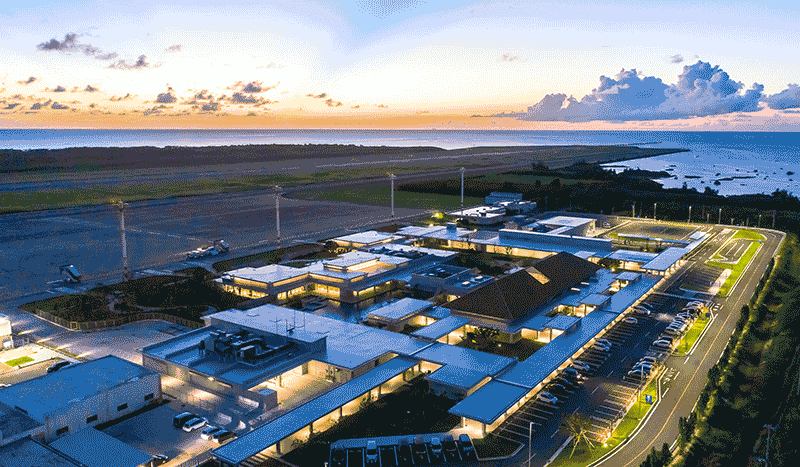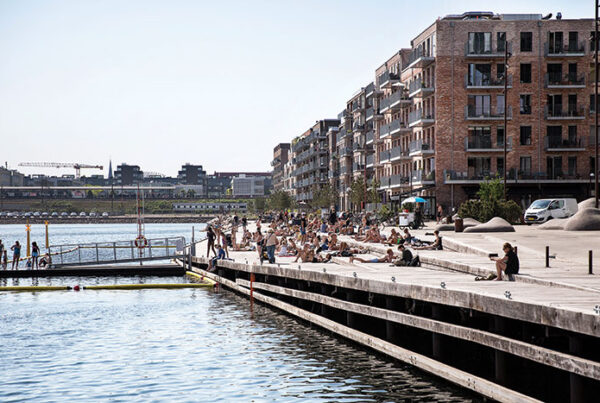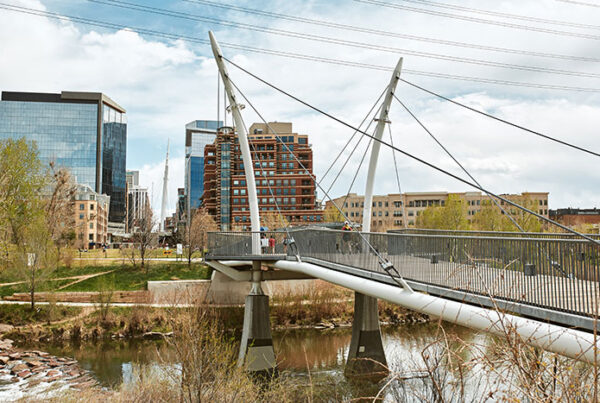
Shimojishima Airport was designed to harmonize with nature to create an environment that supports and improves both the human experience and the surrounding environment.
Around the world, awareness of the global climate crisis continues to grow, building not only knowledge of its impacts, but also action toward reducing, mitigating, and even restoring the damage we have caused to the biosphere.
The design, construction, and operation of the built environment is one area subject to much climate crisis scrutiny, and includes many opportunities for improvement. Investors are taking notice of resilient design and radical energy efficiency, and our collective response is in the spotlight. Reducing carbon emissions is usually the focus for the built environment—and rightfully so—but we often discount the impact that buildings have on people. The recent growth of health and wellness design has put this back in the news and designers and developers are taking note.
One of the built environment’s industries under recent economic stress due to the pandemic is the travel and tourism industry. It has also been under some criticism due to the impacts of travel-related emissions and the fact that tourism, in general, is often seen as optional.
Yet, post-pandemic, one of the things that many people say they look forward to most is traveling again, even though travel can be stressful for most people. People tend to hate traveling but love having traveled. In this case, the destination experience is enjoyable, not the journey. Long airport lines, uncomfortable airport environments—it is usually too hot or too cold and we are sealed off from the outdoors by large windows with too much glare. Add to that narrow airplane seats, noise, and dealing with time zone changes, and travel becomes an uncomfortable experience for most people.

An aerial view of Shimojishima Airport shows the single-story, dispersed layout and traditional red hiproof of the check-in area.
Where Are All the Pilots?
Beginning in the mid-1960s, there was a global demand for jet pilots and the world responded. Japan actually lacked sufficient airfields for training of these pilots, and the Japanese government then requested that airports be developed across Japan, with the main purpose of training jet pilots.
South of Okinawa lies a small group of tropical islands known as Miyako Shimojishima. In response to the government’s request, an airfield was developed there—which opened in 1979, and was used exclusively for pilot training. After 2012, as flight simulators came into favor and more cost-effective pilot training could be conducted overseas, Shimojishima Airport became underused. It was then that the owner and operator of the airport, Mitsubishi Estate Co. Ltd., proposed to the Okinawa prefectural government to build a passenger terminal there.
The owner and operator of the airport then asked the following questions:
- “Can an airport terminal be built in such a way that it adds value and comfort to the user experience?”
- “Can an airport terminal be built that reduces its environmental impacts enough to be net-zero-energy ready?”
The owner also adopted the phrase “Your resort experience begins at the airport” to inspire the design team to focus on the end user and occupant experience.
A Sense of Place
There is a unique sense of place in the Miyako Shimojishima islands that is informed by the surrounding turquoise waters and coral reefs. The native vegetation, the beaches, the openness, and the tropical winds give one an engaged sense of climate and place. Given the beauty and subtropical Okinawan climate, a connection to nature was a logical design response—but how would it be possible to connect to nature in a meaningful way when airports are strictly climate and security controlled, with almost no opportunity for opening up to the outdoors?
The following three key concepts for the terminal building were suggested as a framework for the design process:
- Openness and intimacy(from a terminal building to a resort/cottage) → Scalability on demand.
- Sharing (from waiting areas to spending fun time together) → Increase efficiency by combining functions.
- Controlled/uncontrolled(from separate to aggregate) → Ability to choose how to spend time.
From this background and the owner’s vision it was decided that a terminal building with many of the elements and attributes of biophilic design—and with a high degree of intimacy and choice—would be suitable to the local climate and culture. It was also decided to suppress common industrial airport finish materials and the institutional feeling of most airports as much as possible.

Carefully managing controlled or secure airport areas with uncontrolled areas allowed designers to freely connect passengers with the natural environment.

Lounge area with open window-walls adjacent to outdoor pools and gardens.

Deep roof overhangs (amahaji) of three to five meters (9.8 to 16.4 ft) are a distinct Okinawan architectural feature.
In Harmony with Nature
Biophilic design is more than simply adding some plants in a building or letting in daylight and providing views—it extends to materials, colors, patterns, shapes, and even the form or shape of a space. There is much evidence of how biophilic design improves the human experience from reducing stress, to improving creativity and productivity—to better health and learning outcomes. Shimojishima Airport incorporated many of these principles in the design of the interior of the terminal and then went beyond the basics and connected the terminal perimeter to the tropical climate of Okinawa.
Due to the harsh salt air and strong seasonal winds, the building form is generally dispersed and low, with mostly flat roofs. The check-in area features an Okinawan traditional red-colored hip roof that draws your eye to the entry. Okinawan architectural methods, rooted in the land and climate, such as deep roof overhangs or amahaji of three to five meters (9.8 to 16.4 ft), and hinpun (a talisman to ward off evil spirits), which functionally serves as a windbreak or visual screen at entry points, can both be seen prominently.
On the inside, prefabricated wood made from cross-laminated timber (CLT) is the primary ceiling structure material and there is a natural warmth and glow to the space. This is contrasted by the cool polished concrete and earth tone–colored tile floors. When these materials are combined with the clerestory daylighting, and with the integrated LED lighting, the feeling is that you are not in a commercial airport terminal—there is much more of a resort feeling.
Spaces were formed to facilitate circulation and provide distant views, while providing places of refuge for intimacy and conversation. The perimeter of the check-in area and the waiting lounge have openable glass walls, which directly link to surrounding pools and vegetation. Passengers can choose to sit indoors or outdoors while waiting to board their plane. Outdoors, there is abundant greenery with native plants, pools of water reflecting the clouds and sky, and water can be heard softly falling. It is difficult to imagine an airport where you can see, feel, smell, and even hear nature.
Designing a low-energy-consuming building in a tropical climate that is open to the outdoors must be done with careful planning and skill. Simply opening an air-conditioned building to the outdoors would lead to a drastic increase in energy use and would likely not provide the intended level of comfort.
One of the first steps in the design process was to define comfort using a relatively new comfort index called the standard effective temperature (SET). SET is a concept that is close to the sensible (felt) temperature, considering not only the temperature and humidity but also other parameters, and seeks a new level of comfort where one can feel both nature as well as the artificial environment. This index can be used to evaluate semi-outdoor spaces like a train station platform or an atrium and can reduce air-conditioning loads if designed and controlled properly.
Comfort typically varies from person to person and the air conditioning in this mixed indoor/outdoor environment is not uniform, but is zoned according to the activity level in the terminal, such as check-in areas versus lounge areas. It is also important to select and design a cooling system that offers flexibility in zoning and control.
This building uses a vaporization cooling system using well water and a groundwater heat pump. This kind of system can be operated efficiently according to the season by leveraging the power of nature, using groundwater.
The design team employed a number of digital simulation tools to both predict building performance and later confirm and adjust the operation of the terminal building. In addition to building information modeling (BIM), computational fluid dynamics (CFD) tools were used to model and simulate air flow and temperatures in various building locations, using site-specific climate data. Daylight and views also were simulated to ensure adequate natural light, which reduces energy consumption and improves the human experience and connection to the outdoors. Finally, energy performance simulation tools were used to accurately predict operational performance and ensure that targeted energy efficiency levels could be achieved.

The prefabricated CLT structure forming the underside of the red hipped roof over the check-in lobby.

The warm wood and integrated LED lighting are contrasted by the cool concrete columns and tiled floors.

Daylighting brings nature to the center of this lounge area and the sliding window-walls open up to the outdoors.
The Result
The result is an airport terminal designed to operate using over 70 percent less energy than a comparable baseline building designed to meet building regulations. This qualifies this building as net zero energy ready (NZEr)—a truly outstanding achievement. Post-occupancy actual energy use measurements in 2019 confirmed that the operational energy use could still be reduced further.
In addition to the energy performance and related carbon emissions reductions, by treating all of the wastewater from the airport and using it for toilet flushing, there is a positive impact on the surrounding sea, and the amount of potable well water used was also significantly reduced.

Primary energy consumption reduction of over 70 percent as compared with the Japanese standard. (NIKKEN SEKKEI)
In 2019, a post-occupancy survey was conducted during the hottest month, September. The results of the questionnaire indicate that 97 percent of the respondents are quite satisfied with the overall indoor environment. With 83 percent saying they were satisfied with the thermal environment, 88 percent were satisfied with the light level, and 93 percent were satisfied with the connection to nature. The results show that users were very positive about the open windows.
For example, many comments indicated that the breeze was pleasant and they welcomed the openness. With COVID-19, there are increased health benefits to having an open-air building—increased natural and artificial ventilation helps manage airborne viruses.

User satisfaction levels with the airport terminal environment. (NIKKEN SEKKEI)
Lessons Learned for Urban Offices
This project proved that an airport terminal building can be designed and constructed in a tropical climate while being open to nature, but what can be learned that might be able to be applied to urban offices in similar hot/humid and tropical climates? When we work in the office full time, it is quite a different experience than being a transient passenger at an airport terminal.
As the use of activity-based working (ABW) environments increases in popularity, giving office employees increased choices in the type of seating, brightness, and even thermal comfort (cool/cold, warm/hot) has proved to be valuable in employee surveys. ABW environments essentially give office workers the opportunity to be more transient within their workplace. Some surveys have shown that workers commonly change their work location from four to nine times per day. Expanding these environments to include semi-outdoor spaces not only adds more choices, but also increases worker comfort, creativity, and productivity.

Semi-outdoor spaces with greater connection to nature support improved human health, creativity, and productivity. (NIKKEN SEKKEI)
By connecting to and feeling nature in a design, the range of comfortable thermal environments expands. In order to feel nature, it is necessary not only to recognize the connection to visual things such as greenery and water or materials, but also to connect the other senses with wind, sounds, sunlight/shade, and smell. To achieve this, it is necessary to carefully design spaces to enhance open-air connections between nature and the building.
 By examining proposed air-conditioning systems and building performance in detail and making operational measurements and adjustments, such as opening windows, it is possible to realize open-air buildings that do not result in an excessive energy increase. To achieve this success, detailed research and examination using computer simulation tools is essential at the early design stage.
By examining proposed air-conditioning systems and building performance in detail and making operational measurements and adjustments, such as opening windows, it is possible to realize open-air buildings that do not result in an excessive energy increase. To achieve this success, detailed research and examination using computer simulation tools is essential at the early design stage.
Shimojishima is a truly unique and special place where people can really connect with nature. This airport design extends that experience so that passengers and even regular occupants can feel more relaxed than they might expect as they wait for their departing flight or conduct their work there.
JAMES SCOTT BREW is a senior sustainability and wellness architect with NIKKEN SEKKEI, Tokyo. TAKUYA ASAGAWA is a mechanical engineer with NIKKEN SEKKEI, Tokyo, and was the lead engineer for this project. NAOYUKI HARADA is a built environment engineer with NIKKEN SEKKEI, Tokyo.



